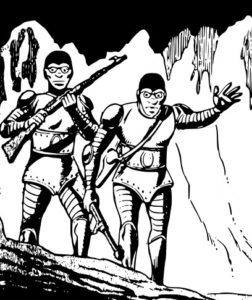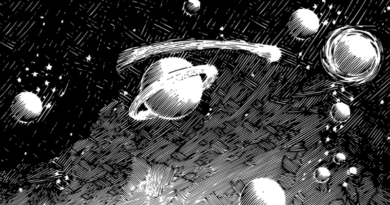BX Space – Dungeon Adventures in Outer Space Science Fantasy
A Scene from Arachnids of the 9th Planet!
Scene: A rocket ship touches down with a fiery blast on the rocky surface of the 9th planet and the hatch swings open.
Captain Mike: Agh! Look this place is crawling with Crab Space Spiders!
First Officer Elizabeth: At least they weren’t Space Spider Crabs, those are awful…
Deadly Doc Corbett: Just burn em! (waves ray gun) (mumbles) aren’t these “Space Crab Spiders?”
Introduction
BX Space! What is it? A simple (I hope) set of rules that bolt onto classic rules and known rules and which allow Space Masters to run dungeon adventures in outer space. The intention is, over the next few weeks, to present a series of articles, and finally a PDF of the rules. The BX Space rules will be released under the auspices of the OGL. Without further delay, lets begin!
Purpose
The purpose of BX-Space is to set forth the basic tenets of Dungeons in Outer Space Science-Fantasy. The intent is to create additional rules which “bolt-on” to classic rules or known rules which emulate the RPG rules of the 1980s.
Stylistically the theme of BX Space is necessarily one of a Medieval Futurism. Far from realistic, in our science fantasy almost any planet in orbit of a sun may be expected to be inhabited by strange alien monsters and on most planets the characters may come and go without using a Space Suit. For the most part Space Suits are only used – in the vacuum of space!
Scope
Setting
Known rules are emulations in the play style of games of the 1980s, principally fantasy rulesets, in which Player Classes explore wilderness and dungeons; characters advance in level by accumulating XP retrieving treasure and fighting Monsters.
BX-Space as Science Fantasy merely enables the application of the above concept within a broadly defined science fantasy genre.

The intended scope of the setting is planetary or interstellar. Player Characters board a small Rocket Ship and journey from their home planet to asteroids, moons, and planets. Space is now “wilderness”. A “dungeon” may now be found on a rogue moon under the ruin of an alien outpost; characters advance in level by accumulating XP “retrieving treasure” and fighting Monsters. A “dungeon” may also be a derelict ship floating in the wastes of space, etc.
Rules
At this initial state of the project the rules will augment known rules emulations of rules of the 1980s and covers only the first three character levels. Existing known rules will not be replaced and will be considered to also be in force.
Magic & Science
Magic rules will still be in force. How “magic” works is not as important as the effect implemented. That is, we accept that the means by which the effects are produced are not as important as the resulting effect.
BX Space as Science Fantasy will implement the same magical effects through gadgets and machines. Science Fantasy gadgets and machines therefore will “work” in parallel with “magic”. The reader may want to bear in mind that this Science Fantasy is not meant to be rigorous scientifically, broadly it is “rubber science”.
Armour Class & Damage
The Armour Class of known rules will be used. These rules will not create any AC which is invulnerable to the existing attack rules. These rules will not create any form of damage, aside from blast damage, which exceeds the scope of d4 through d10 per the known rules of Variable Weapon Damage. If variable damage is not used all damage is d6.
This author anticipates at least one argument, that AC should be irrelevant for a ray gun or firearm. This argument would likely be rooted in the idea that classic rules or known rules mechanics are an accurate medieval simulation. This is a sketchy notion at best as one may counter that AC is hardly a successful simulation for missiles, even arrows. The point is that a rule need not be at all realistic to be fun. The reader may content themselves with the idea that rules of this game need only be internally consistent with the known and accepted mechanics, so go with it. In the end the resulting game will not be any less enjoyable as it is after all a game of fantasy.

Mechanics
d100 Test Tables
The Test Tables include an Escape Number, Gravity Number, Route Number, Ship’s Armour Class, and Test Number.
A Test Number grants the Space Master a tool for quantifying almost any adversarial task; a Test number of 9 represents the least difficult task and Test Number of 2 represents the most difficult task. A Test Number of 4 requires a player whose character is 1st to 3rd level to roll 71 or better on d100 to succeed. Roll equal to or better than the Check Number to succeed.
d100 Test Table
|
Character’s Level |
Escape Number, Gravity Number, Route Number, |
||||||||||||
|
9 |
8 |
7 |
6 |
5 |
4 |
3 |
2 |
1 |
0 |
-1 |
-2 |
-3 |
|
|
Normal Man |
51 |
56 |
61 |
66 |
71 |
76 |
81 |
86 |
91 |
96 |
96 |
96 |
96 |
|
1st to 3rd |
46 |
51 |
56 |
61 |
66 |
71 |
76 |
81 |
86 |
91 |
96 |
96 |
96 |
|
4th + Higher |
36 |
41 |
46 |
51 |
56 |
61 |
66 |
76 |
81 |
86 |
91 |
96 |
96 |
Note – d100 Check Numbers may be converted to d20 using the following table. d100 dice roll modifiers of +5% or -5% convert to d20 values of +1 or -1 respectively.
|
d100 |
01 |
06 |
11 |
16 |
21 |
26 |
31 |
36 |
41 |
46 |
|
d20 |
1 |
2 |
3 |
4 |
5 |
6 |
7 |
8 |
9 |
10 |
|
d100 |
51 |
56 |
61 |
66 |
71 |
76 |
81 |
86 |
91 |
96 |
|
d20 |
11 |
12 |
13 |
14 |
15 |
16 |
17 |
18 |
19 |
20 |
Damage
Damage from weapons is 1d6, (compatible with classic known rules), or if variable damage is used consult the following table.
Science Fantasy Weapon Damage
|
Damage |
Weapon Type |
Load |
|
2-12 (2d6)1 |
Blast, Grenade |
N/A |
|
3-18 (3d6)1 |
Blast, Bomb |
N/A |
|
4-24 (4d6)1 |
Blast, Mine or Ships Cannon |
1 |
|
1-6 (1d6) |
Firearm |
1, 5, 10, 20 or 30 Bullets |
|
1-8 (1d8) |
Ray Gun, Disintegrating,“Blaster” |
20 Charges |
|
Paralysis – An attack will paralyze any man size or smaller creature hit successfully (except elves or robots) unless the victim saves vs. Paralysis. This paralysis is the normal type (lasting 2-8 turns) unless removed by a cure light wounds spell. |
Ray Gun, Paralysing, “Stunner” |
20 Charges |
|
1-6 (1d6) |
Robot Buzz Saw |
|
|
1-6 (1d6) |
Robot Claw |
|
|
1-6 (1d6) |
Robot Drill |
|
|
1-4 (1d4) |
Robot Electrical Discharge |
|
|
1-8 (1d8) vs. Ship, |
Ship Cannon |
Note 1 – Damage may be halved with a successful Saving Throw.
Ray Gun and Firearm Missile Ranges (In Feet)
|
Weapon Form |
Short (+5% [+1]) |
Medium (0) [0] |
Long (-5% [-1]) |
| Personal |
5-10 |
11-30 |
31-50 |
| Intermediate |
5-70 |
71-140 |
141-210 |
| Extended |
5-80 |
81-160 |
161-240 |
Missile Weapon Rate of Fire Rules
Rate of Fire grants a dice roll modifier vs. a single target based on the amount of ammo expended. The concept may be optionally extended to Bows, but not Crossbows, if the Space Master so wishes.
|
Ammo Expended |
Dice Roll Modifier |
|---|---|
|
Normal, single shot |
0 |
|
Burst, 5 Charges or 5 Bullets |
+5% [+1] |
|
Spray, 10 Charges or 10 Bullets |
+10% [+2] |
|
Arrow, single shot |
0 |
|
Arrows (2) |
+5% [+1] |
|
Arrows (3) |
+10% [+2] |
Saving Throws
Saving Throw tables will be broadened for the genre. A Saving Throw represents the chance that a special attack may be avoided or will have less than the normal effect. This chance is given as a Check Number on the d100 Saving Throw charts. Roll equal to or greater than the number to succeed.
d100 Character Saving Throws
|
Class |
Space Suit Puncture |
System or Gadget |
Vacuum of Space1 |
Radiation |
Virus |
|
Salvage a Ship System in ½ the Time |
Blast, Mines or Cannon |
Repair a Ship System in ½ the Time |
Window |
No Air |
|
|
Normal Man |
66 |
71 |
76 |
81 |
81 |
|
Clerics |
51 |
56 |
66 |
76 |
81 |
|
Dwarves |
46 |
51 |
56 |
61 |
66 |
|
Elves |
56 |
61 |
61 |
71 |
71 |
|
Fighter |
56 |
61 |
66 |
71 |
76 |
|
Halflings |
46 |
51 |
56 |
61 |
66 |
|
Magic Users |
61 |
66 |
61 |
76 |
71 |
|
Robot |
46 |
51 |
56 |
61 |
66 |
|
Thieves |
61 |
66 |
61 |
76 |
71 |
Note 1. Vacuum of Space does not affect Robots.
Note – d100 Check Numbers may be converted to d20 using the following table. d100 dice roll modifiers of +5% or -5% convert to d20 values of +1 or -1 respectively.
d100 to d20 Conversion Table
|
d100 |
01 |
06 |
11 |
16 |
21 |
26 |
31 |
36 |
41 |
46 |
|
d20 |
1 |
2 |
3 |
4 |
5 |
6 |
7 |
8 |
9 |
10 |
|
d100 |
51 |
56 |
61 |
66 |
71 |
76 |
81 |
86 |
91 |
96 |
|
d20 |
11 |
12 |
13 |
14 |
15 |
16 |
17 |
18 |
19 |
20 |
Damage from No Air
A character without air, assuming they need air to breathe, suffers 1d6 damage per Turn.
Damage from Vacuum
A vacuum causes 1d6 Damage per round.
Damage from Radiation
Radiation causes 1d6 Damage per Turn.
Virus
Biological – Characters may be damaged by a virus. A virus may be spread by air or by contact. The amount of damage a virus causes and its duration are at the Space Master’s discretion.
Software – Computers, Robots, and Systems may be rendered damaged or inoperative by a virus. Virus are spread by Data Link connections.
d100 Rocket Ship Saving Throws
|
Ship Class |
System Saving Throw |
|
Merchant |
51 |
|
Pirate |
61 |
|
Player |
56 |
|
Scout |
51 |
|
Warship |
46 |
Next Articles – Equipment and The Robot Class



